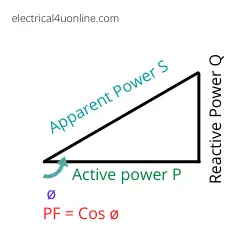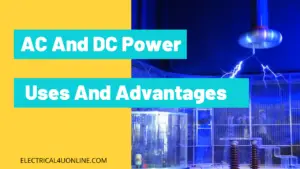Table of Contents
What Is Apparent Power?
Apparent Power is a term used in electrical engineering to describe the total power in an AC (alternating current) circuit.
It combines real power (the power that performs actual work) and reactive power (the power that oscillates back and forth but does not network). Apparent power is represented by the symbol S and is measured in volt-amperes (VA).
In an AC circuit, power is split into two parts: real power and reactive power. Real power, measured in watts, is the actual power used to perform work, like producing heat, light, or motion. Reactive power, measured in VAR (volt-amperes reactive), is the power that moves back and forth between the source and reactive components in the circuit without doing any useful work.
Why Is Apparent Power Important?
Apparent power is important because it represents the total power required to operate an electrical system, including both the usable and unusable parts. Here’s why it matters:
-
System Sizing: Electrical equipment like transformers, generators, and wires are rated based on apparent power (in VA, kVA, or MVA). Knowing the apparent power ensures the system can handle the total demand safely.
-
Understanding Power Flow: Apparent power includes both real power (which does useful work) and reactive power (which supports energy transfer but doesn’t do work). It gives a complete picture of the load on the system.
-
Efficiency and Power Factor: Apparent power helps identify inefficiencies. A low power factor (the ratio of real power to apparent power) means more current is needed to deliver the same amount of work, leading to energy losses and higher costs.
-
Voltage and Current Control: Apparent power directly affects the amount of current flowing through the system. High apparent power can lead to voltage drops, overheating, and reduced system performance.
-
Cost Management: Utilities often charge businesses based on apparent power or penalize them for poor power factors. Managing apparent power helps reduce these costs.
In short, apparent power is crucial for designing, managing, and optimizing electrical systems efficiently and safely.
Delve into the Intriguing World of Apparent Power and its Crucial Role in Modern Energy Systems! with Our In-Depth Article The importance of apparent power!
Apparent power formula
The basic formula for calculating apparent power for any circuit is:
- The apparent power formula single phase S = V*I
- The apparent power formula three phases S = √3 *V*I
The apparent power Unit is Volt Ampere (VA). If the apparent power in the electric circuit is supplied from a power supplier to the grid. It includes both real & reactive power consumption in the loads.
With the help of the power triangle formula, which shows the relationship between apparent, active, reactive power, and power factor we can find another apparent power formula as follows.

From the power triangle we find S = √ (Active Power2 + Reactive Power2)
Or
S = √(Q2 + P2)
where
- is the apparent power in volt-amperes (VA)
- Q is reactive power consumption in load (VAR)
- P is active power consumption in load (W)
calculation Example
Assume we have a three-phase 10 KW load working on a 400 Volt power source. This Load has a 0.85 power factor. We need to calculate the apparent power of this load.
In this example, we have the load active power which is 10 KW, And the power factor of the load is 0.85 we calculate the current first as follows
P = √3 V * I * PF ⇒ I = P / (√3 *V * PF ) = 10,000/(1.73*400*0.85)
I = 17 A
Then, S =√3 V * I
S = 1.73*400*17 = 11.7 KVA
Note that, the active power is greater than the apparent one. This means that this load draws reactive power.
This is clear as the PF is 0.85 (the lower the power factor, the smaller the active power), For more information, read my article about factors that affect apparent power here.
Could S(KVA) be less than P(KW)? S is either less than or equal to P. In the case of unity PF the two powers are equal.
Applications of Apparent Power
Apparent power has several practical applications in various fields, particularly in electrical engineering and power systems. Some of the key applications of apparent power include:
-
Power System Design: Apparent power is crucial in the design of electrical power systems, helping engineers determine the appropriate ratings for equipment such as transformers, generators, and transmission lines.
-
Load Management: Understanding apparent power allows for effective load management in power distribution systems, enabling operators to balance the supply and demand of power more efficiently.
-
Power Factor Correction: Apparent power is closely related to power factor, so it is essential in implementing power factor correction techniques to improve the efficiency of electrical systems, reduce energy consumption, and optimize power usage.
-
Electrical Equipment Sizing: Apparent power helps in sizing electrical equipment to ensure that it can handle the expected loads without becoming overloaded, thus preventing equipment failures and ensuring reliable operation.
-
Voltage Regulation: Apparent power is used to regulate voltage levels in power distribution systems, helping to maintain stable and consistent voltage for consumers and preventing voltage fluctuations that could potentially damage electrical equipment.
-
Power Quality Analysis: Apparent power analysis is a part of assessing power quality in electrical systems, helping to identify issues such as voltage fluctuations, harmonics, and other power-related anomalies.
-
Energy Billing and Cost Management: Apparent power is a factor in determining electricity bills, especially for commercial and industrial consumers. Understanding and managing apparent power is crucial for optimizing power usage and avoiding excessive charges.
-
Renewable Energy Systems: Apparent power plays a significant role in the integration of renewable energy sources into the grid, as it helps manage the variability and intermittency of power generation from sources like solar and wind.
For more information about Apparent power Applications, read my article here.
Differences Between Apparent Power and Real Power
|
Apparent Power |
Real Power |
|
Apparent power is the combination of both real and reactive power. Total Power in a circuit dissipated and returned power. |
The actual amount of dissipated or used power in the circuit is usually called real power |
|
Apparent power is symbolized by the capital S |
Real Power is symbolized by the capital P |
|
The unit of Apparent power is Volt Ampere(VA) |
The unit of Real Power is a Watt |
|
Apparent power in a circuit is actually the function of the circuit’s total impedance |
Real power in a circuit is actually the function of the circuit’s dissipative elements and usually, it is Resistance |
|
Apparent power is the product of the root mean square(RMS) values of the current and voltage |
Real power is the product of the instantaneous values of the current and voltage in the circuit |
|
In the AC Circuits, the total flow of the electric power is apparent power whether useful or not useful. |
The portion of the total power(apparent power) which does the useful work in the system is a real or active power |
|
The apparent power formula is S = V * I |
The real or active power formula is P = V I cos ø |
I have written a detailed article about Power Factor Correction, you can check it for more information.
Power Triangle

A power triangle is a graphical representation used in electrical engineering to visualize the relationships between real power (P), reactive power (Q), and apparent power (S) in an AC circuit.
It is a way to illustrate these power components and their respective magnitudes and phase differences. The power triangle helps in understanding the power relationships in a circuit where there might be a phase difference between voltage and current.
In the power triangle:
- The horizontal component represents real power (P), measured in watts (W). It indicates the actual power that is consumed in the circuit and performs useful work.
- The vertical component represents reactive power (Q), measured in volt-amperes reactive (VAR). It represents the power that flows back and forth between the source and reactive elements in the circuit, without performing any actual work.
- The hypotenuse of the triangle represents the apparent power (S), measured in volt-amperes (VA). It is the combination of both the real power and the reactive power and represents the total power in the circuit.
The power triangle equation is S2=P2+Q2 The power triangle is a useful tool for visualizing the power relationships and understanding concepts such as power factor, which is the cosine of the angle between the real power and the apparent power.
For more information about Power Factor read my article Power Factor Correction, 8 Important Answers.
Don’t Leave Empty-Handed!
Install my Free Android App on Google Play:
Electrical Cables Most Common Tables “Cables Tables”
And, my Electrical Calculations App “Fast Electrical Calculator”
Discover more great content by subscribing to My channel
Looking to stay ahead of the game in the world of electrical engineering? Subscribe to my YouTube channel and gain access to exclusive content you won’t find anywhere else!
The staff I recommend
(Amazon Affiliate Links to products I believe are high quality):
- Economy 120 Volt/60Hz AC Power Source – Step-Down Voltage & Frequency Converters 1800W
- UNI-T Digital Multimeter Tester UT139C
- 50-Amp Extension Cord for RV “100ft”
- Voltage Stabilizer 110/220v
- Hair Dryer “best selling“
- TOSHIBA EM131A5C-BS Countertop Microwave Ovens
Disclaimer: This contains affiliate links to Amazon products. I may earn a commission for purchases made through these links.

